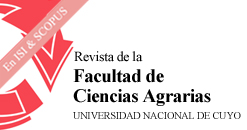Artículo de revista
Sesquióxidos de hierro en bosques templado húmedos del estado de Hidalgo, México
Sesquioxides of iron in moist temperate forests of the state of Hidalgo, Mexico
Acevedo Sandoval, Otilio Arturo
México. Universidad Autónoma del Estado de Hidalgo.
-  Enviar un email al autor
Enviar un email al autor
Chavez, Enrique Cruz
México. Universidad Autónoma del Estado de Hidalgo.
-  Enviar un email al autor
Enviar un email al autor
Sánchez, Misael Cruz
México. Universidad Autónoma del Estado de Hidalgo.
-  Enviar un email al autor
Enviar un email al autor
Prieto García, Francisco
México. Universidad Autónoma del Estado de Hidalgo.
-  Enviar un email al autor
Enviar un email al autor
Prieto Méndez, Judith
México. Universidad Autónoma del Estado de Hidalgo.
-  Enviar un email al autor
Enviar un email al autor
Publicado en el 2014 en
Revista de la Facultad de Ciencias Agrarias,
Vol. 46, no. 1
Idioma:
Español
Resumen:
Español
Se estudian las formas de hierro extraídas
con oxalato ácido de amonio, pirofosfato de
sodio, ditionito-citrato-bicarbonato, así como el
hierro total en disolución en suelos Alisoles en
el municipio de Acaxochitlán, Hidalgo, México.
Los suelos estudiados soportan distintos
tipos de vegetación forestal: Pinus patula
Schlecht and Cham (Pp), Pinus teocote, (Pt)
y Quercus spp, (Q). El objetivo del trabajo
fue determinar si la vegetación influye
significativamente sobre las diferentes fracciones
de hierro (Fe) en el suelo. Los contenidos de Fe
total son significativamente mayores en suelos
bajo vegetación de Pp (14,5% de Fe2O3), el
mayor porcentaje de ferrihidrita (38,0% del Fe
total en suelo) y de complejos organominerales
de Fe y óxidos amorfos de Fe (20,9% y 16,3%
respectivamente del Fe total en suelo, se
dio en el bosque de Pt. En los suelos bajo
bosques de Pp predominaron formas de Fe lábil
(56,7% del Fe total en suelo) y formas cristalinas
de Fe (goetita/hematita). La vegetación de Q
mostró mayor alteración de los suelos y en el
caso de Pt y Pp se presentó una mayor evolución
en el proceso de organización estructural de
los oxihidróxidos de Fe. El tipo de vegetación
forestal influye en el grado de evolución del
suelo, y en la distribución, contenido y formas
de óxidos de Fe. En un orden de mayor a
menor el contenido de Fe total en el suelo fue
Pinus patula > Quercus spp > Pinus teocote.
Inglés
Total iron dissolved and iron
forms extracted with acid ammonium
oxalate, sodium pyrophosphate and
dithionate- citrate- bicarbonate were studied in
Alisol soils in the municipality of Acaxochitlán,
State of Hidalgo, México. The studied soils
present different kind of forests: Pinus patula
schlecht and Cham (Pp), Pinus teocote, (Pt)
and Quercus spp, (Q). The objective of this
investigation is to determinate if the vegetation
modifies the different fraction of iron (Fe)
in the soil. The highest total iron content
(14.5% of Fe2O3) was observed in the soils with
Pp vegetation, the highest percent of ferrihydrite
(38.0% of total Fe present in the soil) and of
iron-organic matter complex and amorphous
iron oxides (20.9% and 16.3% respectively of
total Fe in the soil) were found in the Pt forest.
Free iron forms (56.7% of total Fe in the soil)
and crystalline iron forms (goethite/ hematite)
were predominant in the soils with Pp forest.
The most weathered soil was the one with
Q vegetation, a higher evolution in the process
of iron oxi-hydroxides structural organization
was found in the soils with Pt and Pp. The
type of forest vegetation influences the degree
of soil evolution, and distribution, content
and forms of Fe oxides in order of highest
to lowest total Fe content in the soil was
Pinus patula > Quercus spp > Pinus teocote.
Disciplinas:
Palabras clave:
Descriptores:
Acevedo Sandoval, Otilio Arturo; Chavez, Enrique Cruz; Sánchez, Misael Cruz; Prieto García, Francisco; Prieto Méndez, Judith (2014) "Sesquióxidos de hierro en bosques templado húmedos del estado de Hidalgo, México: ". En: Revista de la Facultad de Ciencias Agrarias, Vol. 46, no. 1, p. 109-123.
Dirección URL del artículo: https://bdigital.uncu.edu.ar/6423.
Fecha de consulta del artículo: 18/05/24.

Este obra está bajo una Licencia Creative Commons Atribución-NoComercial-CompartirIgual 3.0 Unported.
Conozca más sobre esta licencia >



